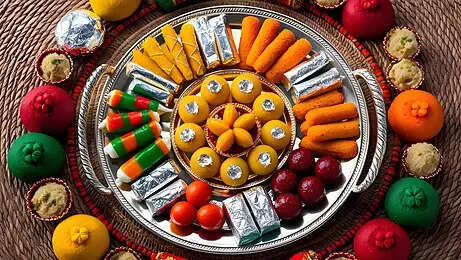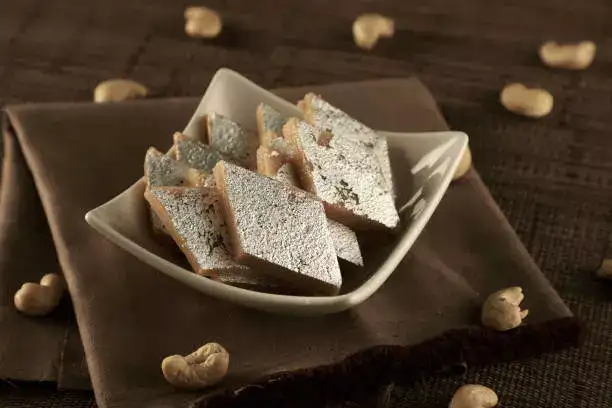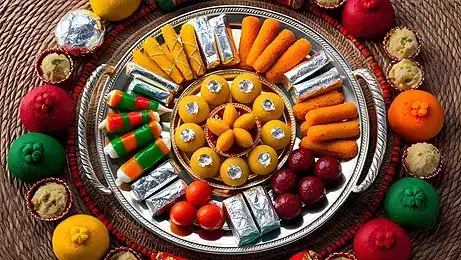The Tradition Behind Silver and Gold Vark on Indian Sweets Explained
Walk into an Indian sweet shop during festival season, and you’ll be greeted by a quiet sparkle kaju katli, barfi, and laddoos glowing under thin sheets of silver and gold. This edible foil, known as vark, is far more than decoration; it is a tradition steeped in history, art, and devotion, turning every sweet into a symbol of celebration.
A Craft Forged in Metal and Memory
Vark is created by hammering pure gold or silver into sheets so thin they appear almost weightless. Traditionally, artisans placed tiny fragments of silver between parchment layers and beat them repeatedly until delicate sheets formed. Today, plant-based or synthetic papers replace animal parchment, preserving both the art and ethical standards. Cities like Jaipur, Varanasi, and Lucknow remain strongholds where family-run workshops continue this intricate craft.
From Mughal Courts to Everyday Celebrations
The use of edible metals in India began in the Mughal courts, where food was designed to dazzle. Inspired by Persian traditions, gilded sweets turned simple confections into royal indulgences. Over time, vark moved from palaces to households, becoming a hallmark of festivals and celebrations. Silver-topped sweets today carry a quiet legacy of luxury and prosperity.

Ayurveda and the Healing Power of Precious Metals
Before its association with royalty, vark had roots in Ayurveda. Silver was believed to cool the body, purify the blood, and fight inflammation, while gold symbolized vitality, strength, and longevity. The philosophy was simple: food should heal as much as it delights.
Faith, Purity, and Divine Offerings
Vark also carries spiritual significance. Silver represents purity and generosity, while gold symbolizes abundance and blessings from Goddess Lakshmi. During festivals like Diwali, Janmashtami, and Eid, vark-covered sweets are offered as prasad, expressing devotion and gratitude. In Jain temples, silver foil decorates idols and sacred spaces, making even a small metallic shimmer a gesture of reverence.

A Modern Symbol of Celebration
Today, vark continues to dazzle. Premium sweets are priced higher when adorned with silver or gold, signaling luxury. Contemporary chefs use vark creatively on desserts, cocktails, and festive gifts. From royal kitchens to modern patisseries, vark still shines as a timeless symbol of beauty, joy, and prosperity.
From ancient courts to modern sweet shops, vark connects India’s past with its present, blending art, culture, and devotion. More than a glittering garnish, it tells stories of health, faith, and celebration. Each silver or gold sheet is a reminder that in India, even the simplest sweet can carry the weight of tradition and the sparkle of joy.

A Craft Forged in Metal and Memory
Vark is created by hammering pure gold or silver into sheets so thin they appear almost weightless. Traditionally, artisans placed tiny fragments of silver between parchment layers and beat them repeatedly until delicate sheets formed. Today, plant-based or synthetic papers replace animal parchment, preserving both the art and ethical standards. Cities like Jaipur, Varanasi, and Lucknow remain strongholds where family-run workshops continue this intricate craft.
From Mughal Courts to Everyday Celebrations
The use of edible metals in India began in the Mughal courts, where food was designed to dazzle. Inspired by Persian traditions, gilded sweets turned simple confections into royal indulgences. Over time, vark moved from palaces to households, becoming a hallmark of festivals and celebrations. Silver-topped sweets today carry a quiet legacy of luxury and prosperity.
You may also like
- Candlelight® by Live Your City Presents First-Ever Open Air Concert in Bengaluru at The Bay at Ecoworld
- ECI directs State CEOs to finalise preparations for nationwide SIR
- Yubi's FY25 Net Loss Rises 5% To INR 416 Cr Despite 36% Revenue Uptick
- Experience Karnataka's Flavours with “Ruchi Yatre: Mandya to Mysuru” at The Verandah
- TN rains: CM Stalin's Tenkasi visit rescheduled to Oct 28

Ayurveda and the Healing Power of Precious Metals
Before its association with royalty, vark had roots in Ayurveda. Silver was believed to cool the body, purify the blood, and fight inflammation, while gold symbolized vitality, strength, and longevity. The philosophy was simple: food should heal as much as it delights.
Faith, Purity, and Divine Offerings
Vark also carries spiritual significance. Silver represents purity and generosity, while gold symbolizes abundance and blessings from Goddess Lakshmi. During festivals like Diwali, Janmashtami, and Eid, vark-covered sweets are offered as prasad, expressing devotion and gratitude. In Jain temples, silver foil decorates idols and sacred spaces, making even a small metallic shimmer a gesture of reverence.

A Modern Symbol of Celebration
Today, vark continues to dazzle. Premium sweets are priced higher when adorned with silver or gold, signaling luxury. Contemporary chefs use vark creatively on desserts, cocktails, and festive gifts. From royal kitchens to modern patisseries, vark still shines as a timeless symbol of beauty, joy, and prosperity.
From ancient courts to modern sweet shops, vark connects India’s past with its present, blending art, culture, and devotion. More than a glittering garnish, it tells stories of health, faith, and celebration. Each silver or gold sheet is a reminder that in India, even the simplest sweet can carry the weight of tradition and the sparkle of joy.









